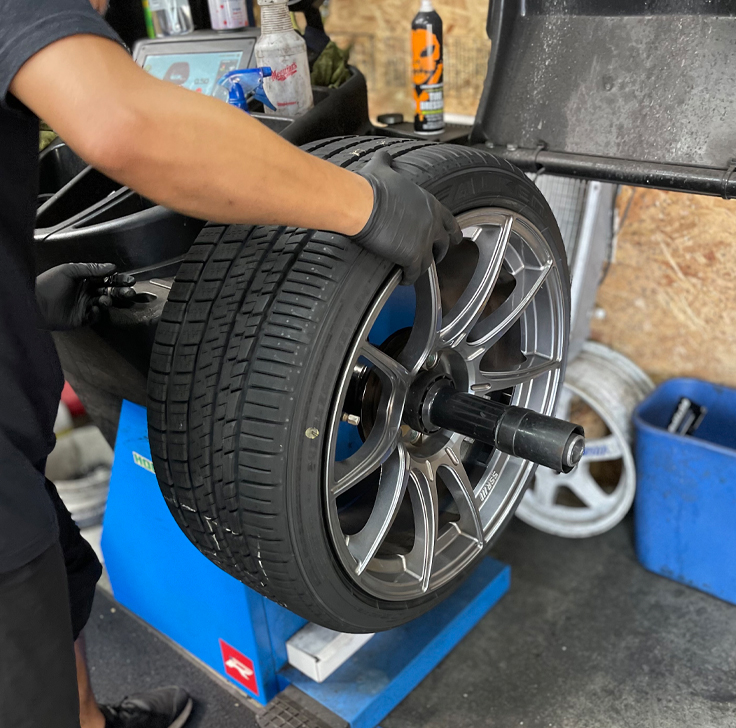Maintenance | Falken Tires

Proper Inflation & Fuel Economy
Ensure maximum performance and a long life from your tires by checking the air pressures at least once a month and set them to the vehicle manufacturer’s recommended pressure(s) listed on the vehicle’s tire placard or in your owner’s manual. Always check and adjust your air pressure when your tires are cold, preferably first thing in the morning before driving. Never release air pressure from tires when they are hot. Wait until the tires cool down and recheck, adding air or releasing as required. Falken endorses the use of nitrogen in your tires because it helps your tires maintain optimal pressure for longer periods of time and reduces the amount of moisture inside of the tire and wheel assembly.
*Some plus size applications may require different air pressure(s) than what is listed on your vehicle’s placard or owner’s manual. In this case, please consult your tire dealer or Falken Tire for proper inflation pressure(s).

Rotation & Wear
Falken recommends rotating your tires at least every 5,000 miles (8,046 km) and periodically inspecting your tires to make sure they are free of road hazards (such as nails, screws, large wood splinters, etc.) that might penetrate your tires causing them to lose air pressure and to ensure they are wearing evenly. Common irregular wear patterns are: misalignment wear, where the tire shows excessive outer or inner tread wear. Improper inflation: tires that are under inflated will exhibit both shoulders of the tread wearing down at a faster rate, while overinflated tires will have the center tread area wearing down at a faster rate. Tire sidewalls should also be inspected for cuts, snags, bruises, and weather cracking. If any of these noted conditions are present during inspection, we recommend returning to your servicing tire dealer to be corrected to ensure long tire life.

Plus Sizing Tires
Plus sizing your wheels and tires is one of the easiest ways to dramatically change the looks of your vehicle. Falken recommends no more than a 3% +/- change in the replacement tires’ overall diameter, so as to remain as close to O.E. specifications as possible and keep your vehicle’s odometer, speedometer, and anti-lock braking system (ABS) functioning correctly, as well as keeping sufficient ground clearance. On sport utility vehicles (SUV) and light trucks, any increase in tire overall diameter and the lifting of vehicle suspension to accommodate the larger tire size, may result in changes of vehicle ride height which will result in changes in rollover characteristics, braking distances, and handling. The plus sized tire’s load index must also be equal to or greater than the O.E. tires’ load index or be able to effectively carry load at a PSI listed on the Load and Inflation Table. Falken Tire also recommends that the speed rating of the replacement tires must always equal or exceed the original equipped tires.

Tire Replacement
Falken recommends replacing your tires when the tread wears down to the wear bars (2/32”), which are located across the tread in several locations around the tire. If only two tires are being replaced, the two new tires should always be installed on the rear of the vehicle to aid in preventing your vehicle from hydroplaning, even if your car is front wheel drive. It’s always recommended to have your new tires balanced during installation, and alignment checked if the previous tires show irregular wear. Tires that have been in use for 5 years or more should continue to be inspected by a qualified tire specialist, at least annually. It is recommended that any tires 10 years old or older from the date of manufacture, including spare tires, be replaced with new tires as a precaution even if such tires appear serviceable and even if they have not reached the legal worn out limit at 2/32”. In the event that you get a flat tire while driving, it is best to find a nearby, safe place to stop and install your spare tire or call a tow truck. The less distance that you drive on your low or flat tire, the better chances your tire has of being repairable. Once you are able to get to your local servicing tire dealer, have them dismount the tire from the rim and thoroughly inspect the inside of the tire. If the interior of the tire, inside and/or outside sidewall are compromised from driving on the flat or underinflated tire for too long, the tire should be replaced. If the tire is deemed repairable after inspection, it should be repaired with a plug and patch or plug/patch combination to correctly repair the tire. Never use a rope type plug, as this does not correctly seal the tire, and may lead to tire failure.

Silent Core Foam Tire Repair Procedure
Thank you for purchasing our Silent Core® noise-absorbing sponge tire. This product reduces the noise associated with tire cavity resonance by adding a noise-absorbing sponge to the inside of the tire. In order to maintain its effectiveness and repair a puncture from the inside of the tire, please read and follow these instructions carefully: Silent Core Foam Tire Repair Procedure.
























